Urban vs. suburban development paradigms for the city
The whole point of the New Urban Transect is that appropriateness of building form is dependent on land use context.

Illustration from The House Book by Keith DuQuette communicates the basic idea of the transect.
The Smart Transportation Guidebook uses the same basic concept about land use context and "regional" vs. "local" serving roads and lays out tables for appropriate roadway design, roadside design, and desired operating speed according to land use context and the use type of the road. (See pages 37-39.)
In cities, it is still a struggle to keep building regulations focused on maintaining urbanism, because for one, most zoning codes are oriented to the car, and two, the real estate development industry has focused on automobile accommodation since the end of World War II. Suburban large tract subdivisions such as Levittown are one example, typical shopping centers--malls, big box, strip shopping centers--are another example.
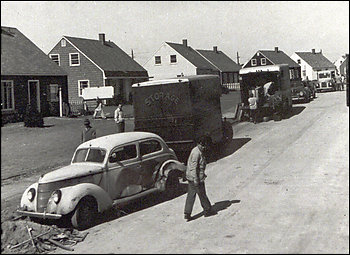
New residents move into their Levitt homes in Levittown, N.Y., in this file photo from October 1947. This prototypical suburban community, known for mass-produced housing that went up for soldiers coming home from World War II, is again trying to standardize a way of life for its residents. This time, they want everybody to go green. Local private businesses like oil companies and light bulb manufacturers are teaming up with nonprofits and the government to canvas all 17,000 homes in the community, trying to encourage residents to reduce its carbon footprint. (AP Photo/Levittown Public Library, File)
The Post has an article about a new development about to break ground on the parking lot at the Rhode Island Metro Station, "Incentives, investment dollars headed for R.I. Avenue."
"Shockingly," the article fails to mention that the key difference in this project is that it is supposed to be urban appropriate, whereas most of the "new" developments along Rhode Island Avenue over the past 25 years have been car oriented. It should be no surprise that compared to more urban parts of the city, car oriented development patterns along roads such as Rhode Island Avenue NE and Georgia Avenue NW, haven't been that successful.

One of the massive failures of vision in terms of promoting the car over urbanism and over transit proximity was the Rhode Island Place development. Also known as the "Home Depot Shopping Center," it is a classic example of suburban design but in the city.
But I think the relative failure of the shopping center at 4th and Rhode Island NE, where stores like Ames, Safeway ("Edgewood mourns loss of anchor Safeway: Some question commitment to black community" from the Post) and National Wholesale Liquidators have failed over the years, is a function of the same phenomenon. The shopping center is set back from the street, counter to typical urbanism.
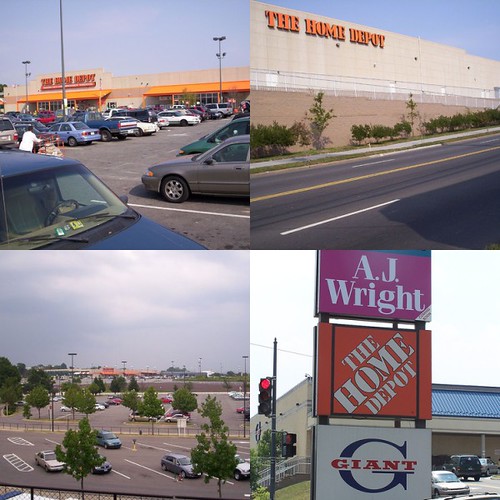
Some people call this "inward suburbanization," and I call it a form of "inner city sprawl." The problem is not unique to DC.
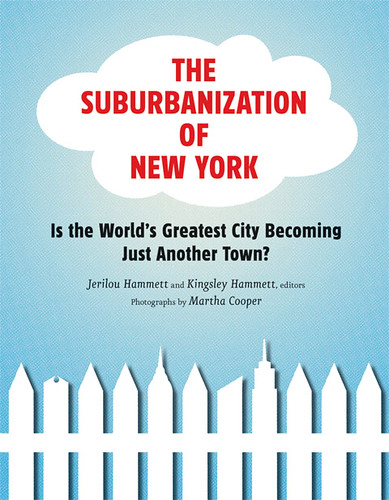
Note that the DC/USA shopping center at Columbia Heights, which is in a neighborhood with more density and somewhat better demographics, has been developed in a distinctly urban fashion, and it is far more successful in terms of shopping, and less so for the car as the 1,000 space parking garage (something I opposed to no avail about 5 or 6 years ago) experiences minimal use.
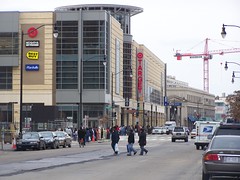
Another aspect of inward suburbanization is the reforming and reproduction of place according to suburban lines. A couple weeks ago, there were articles about the "new" Capital Riverfront District in both the Express, "From Frontier To Focal Point: Capitol Riverfront's Growth and Potential," and the Washington Post, "People flock to live in D.C.'s Capitol Riverfront area despite commercial stall." For the most part, construction in that district is all about the new, in multiunit boxy buildings. Most of the original construction in that area has long been since demolished, although that process started with the creation of the Southeast-Southwest Freeway, which had massive negative impact on the quality of life in that area.
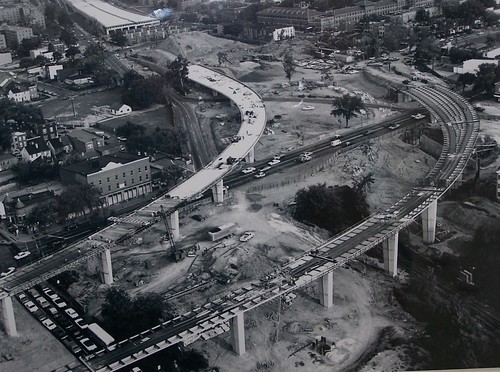
SE-SW Freeway under construction near the Marine Barracks, 1971. DDOT photo.
But I was struck by one of the quotes in the Express article, and how the person referred to he and his fellow residents as "urban explorers." I laughed out loud for a considerable period of time on the train while reading this, struck by the irony that this person is comfortable exploring urbanness in a more spiffy cleaned up de-racinated less authentic manner. From the article:
For now, residents are hunkering down on their little slice of the frontier. The residents share a sense that they are early settlers on a new, unfamiliar patch of Washington real estate. This mentality has evolved into an infectious spirit of community. Says Bolden: "My neighbors are my friends. We call ourselves urban explorers. And we stick together."
Frontier? Their biggest problem is that they have to walk blocks to a restaurant. Where were they when people with choices didn't want to live in the city at all? When living in the city was a statement counter to all the prevalent trends in American Society. When "frontier" meant dealing with dozens of murders in a "pioneering" neighborhood. Etc.
I was watching one of those buying a house shows on HGTV on Saturday--it's interesting to watch these shows both for insights into what motivates and interests people as well as to see different types of houses, floor plans, etc. The person, a 30s aged woman living in the suburbs of Philadelphia, wanted to buy in the city, because she worked in the city and most of her friends lived in the city. But 2 out of 3 of the houses she looked at were relatively new construction, and the historic house was nixed because it was in a mixed use situation--although I probably would not want to live across the street from a BP station either.
But I was struck by the same sense that I received from the articles about the Capitol Riverfront District, that it's fine to consume the "urban" experience if it's made more palatable, more processed, more produced, and less historic.
Anyway, Ken sends us this article from the Sacramento Bee, "Sacramento council OKs environmental report for Curtis Park infill project," which discusses how the neighborhood may sue the city because they believe the project is too suburban, while the local Councilmember is happy for some development.
We see this phenomenon all the time in the city. People are so happy for some investment that they don't care or don't understand that there are appropriate and inappropriate types of development.
Do we have to remake the city into the suburbs in order for cities to thrive again in the 21st century?
From the article:
A potential lawsuit by the Sierra Curtis Neighborhood Association over the project's size and character remains possible. Association leaders told the council Thursday the project's 522 houses and 259,000 square feet of retail space are still too suburban and car-oriented for their early 20th-century neighborhood south of downtown.
The SCNA showed the council 1,200 neighborhood-area signatures backing them. "Please don't view the neighborhood as being against this project. We want a better village. We want an urban environment," said Andrea Rosen, SCNA board member.
Debate among the council and a crowd of 250 ran nearly four hours, with supporters citing their neighborhood's "underserved retail environment" and hopes of seeing a vacant eyesore improved.
Or should we focus on intensifying urbanistically, without dramatically destroying historic fabric and authenticity, focusing on transit, walking, and bicycling rather than the automobile, and promoting the ability to innovate in relatively cheap reusable spaces?
In the meantime, people in the Sierra Curtis Neighborhood Association in Sacramento ought to be commended.
(P.S. It's always amazing to me when I write a planning study for a community and then I hear indirectly about when aspects are getting implemented, exactly as I laid out. I hear that Cambridge, Maryland is writing urban design guidelines for Route 50, and in the study I said that the way Route 50 looks is a scourge on the community which shapes how it is perceived and influences people to not venture inward to the city... I don't understand why it is so hard to do the right thing in DC.)
Labels: car culture and automobility, intra-city sprawl, sustainable land use and resource planning, transportation planning, urban design/placemaking, urban revitalization



0 Comments:
Post a Comment
<< Home